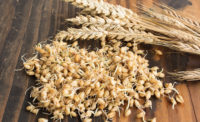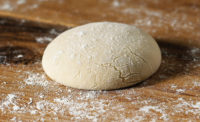There is a new wave in the world of grains available to bakers, pastry chefs and chefs in today’s foodservice industry. In the same way local produce, meat, beer and virtually the whole spectrum of comestibles has evolved, grain production has realized its artisan identity. Some of these grains are “ancient” types that have quickly rooted themselves in the consciousness of consumers via artisan bakeries, and even the mainstream bakery market. Other grain options are simply varieties historically grown in particular regions or climates. Kamut, spelt, Turkey Red, Redeemer, Renan, Edison are just a few of the varieties that possess desirable flavor and bakeability. These latter wheat varieties may be as old as the class of grains vaguely referred to as “ancient.”
Substantial baker and consumer education, and grain-processing infrastructure, was necessary to allow entry of consumer acceptance and availability of these grains. The Bread Bakers Guild of America is a source for extreme baking education, comprised of a concentrated, knowledgeable, curious group of skilled bakers who embrace these grains and expose them to customers. The Bread Lab at the Mount Vernon campus of Washington State University has been a proponent of presenting interesting, unique and useful grains to farmers, millers and bakers. The Bread Lab also hosts The Grain Gathering, an annual event that provides wide-spectrum education to stakeholders in the field. The Kneading Conference in Skowhegan, ME, provides a similar experience in the Northeast. Skowhegan is also home to Somerset Grist Mill, one of the facilities that allows grain and its milled flour to flow into bakeries and kitchens. Across the country, other small mills such as Carolina Ground in Asheville, NC, and Central Milling in Petaluma, CA, are conduits that bring together farmers, millers and bakers to provide high-quality baking ingredients that appeal to consumers’ desire for nutritious, delicious and artisan foods.
But how is this important ingredient—the foundation of the staff of life—being put into production by bakeries? The bakery world has moved swiftly to assimilate these grains in an effort to create (or bring back) flavor profiles that appeal to today’s savvy eater, including the coveted Millennial market. Many of the bakeries I’ve visited over the past year have begun in-house milling programs where whole-grain flours are processed, often from locally grown grains. In Providence, RI, Jim and Lynn Williams have started an adjunct venture to their well-established 7 Stars Bakery. After a trip to the 2014 Grain Gathering at the WSU Bread Lab, the Williams were inspired to procure, mill on premise and bake with varieties of locally grown and ancient grains. The result is Backdoor Bread, available out the back door of the production facility once a week during the winter farmer’s market.
The success is phenomenal; arriving early to the market is necessary to buy a loaf before the “sold out” sign is hung to the disappointment of waiting customers. Early birds have the opportunity to buy bread made from 100 percent house-milled whole-grain flour, including spelt brioche and Kamut hearth loaves. Sarah Williams, production manager at 7 Stars Bakery, says they have applied their decades-plus experience of baking hearth breads with “off-the-pallet” flours to interpret the variances inherent with flour milled from small-scale grain production. Often, key flour characteristics such as protein content and falling number are unknown…and that is when the baker’s skill and experience is crucial to pull something from the oven that is presentable, appealing and delicious. Even King Arthur Flour uses an in-bakery mill to diversify its production offerings and as a teaching opportunity in its baking education center.
It is an exciting time in the baking business. Suddenly, the most-basic ingredient has returned with a lot more character.







